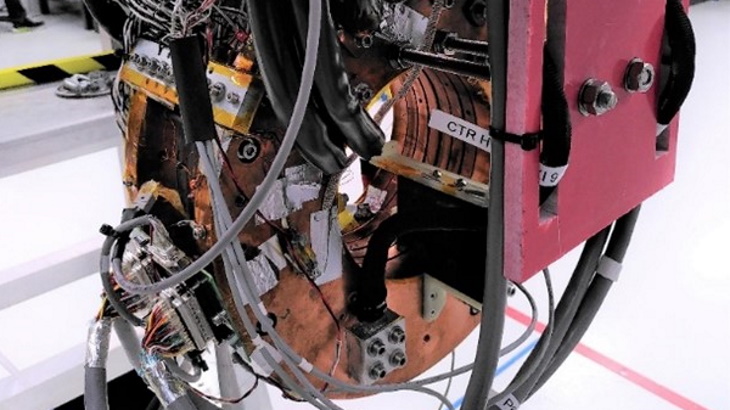Tokamak Energy develops new magnet protection technology
Tokamak Energy of the UK announced it has demonstrated a transformative magnet protection technology that improves the commercial viability of fusion power plants, delivering higher performance than alternative magnet systems. It said results from the latest tests validate a revolutionary approach to scaling up high-temperature superconducting (HTS) magnets, which are highly resilient to plasma disruptions.

Testing of the high-temperature superconducting magnet (Image: Tokamak Energy)
Tokamak fusion reactors use magnets to contain and isolate a plasma so that it can reach the high temperatures at which fusion occurs. High magnetic fields are necessary for tokamaks to contain the superheated fuel, and higher magnetic fields enable a smaller tokamak. High-temperature superconductors can create these much stronger magnetic fields and so are important for commercial fusion power.
Oxford, England-based Tokamak Energy said the new technology, known as 'partial insulation', allows the magnets to be built and operated at power plant size and provides a simpler alternative to traditional superconducting magnet protection systems.
"For the first time, this latest test gives fusion developers an option for a new design of superconducting magnet that will be resistant to damage, reducing the cost and complexity of damage mitigation systems and the threat of downtime," said Tokamak Energy CEO Chris Kelsall. "The world needs energy that is clean, secure, cheap and globally deployable, and the magnets Tokamak Energy is developing will enable this future. Tokamak Energy's two world leading core technologies – the spherical tokamak and HTS magnets – are central to the company's mission to develop economic fusion in compact power plants."
Tokamak Energy - which grew out of the Culham Centre for Fusion Energy, also based in Oxfordshire - is currently manufacturing a new test facility and demonstration system with a full set of magnets. This will test the interaction of all the HTS magnets and validate their use within a full tokamak system for the first time. The new magnet system is scheduled for testing in 2022.
The company is working with CERN, the European Organisation for Nuclear Research, on HTS magnets in developing a proprietary technology that will scale to the large magnets necessary for fusion power modules. HTS magnets also have applications for particle accelerators, aerospace and for several other industrial sectors.
"This impressive demonstration of partial insulation technology opens the door to a new frontier in magnet technology, enabling the novel technology we have developed for our spherical tokamaks to be utilised in a wide range of emerging applications that need high field compact HTS magnets," noted Robert Slade, Advanced Technology Applications Director at Tokamak Energy.
Tokamak Energy has developed the ST-40 compact spherical tokamak. Plans are underway for the ST-40 to operate at plasma temperatures of over 100 million degrees Celsius - almost seven times hotter than the centre of the Sun and the temperature necessary for controlled fusion - in 2021. This, it says, will be a key milestone for commercial fusion and the first privately-funded fusion module to reach this landmark globally.
Researched and written by World Nuclear News
- China Institute of Atomic Energy
- Nuclear Power Institute of China
- Southwestern Institute of Physics
- China Nuclear Power Operation Technology Corporation, Ltd.
- China Nuclear Power Engineering Co., Ltd.
- China Institute for Radiation Protection
- Beijing Research Institute of Uranium Geology (BRIUG)
- China Institute of Nuclear Industry Strategy (CINIS)
- China Nuclear Mining Science and Technology Corporation


